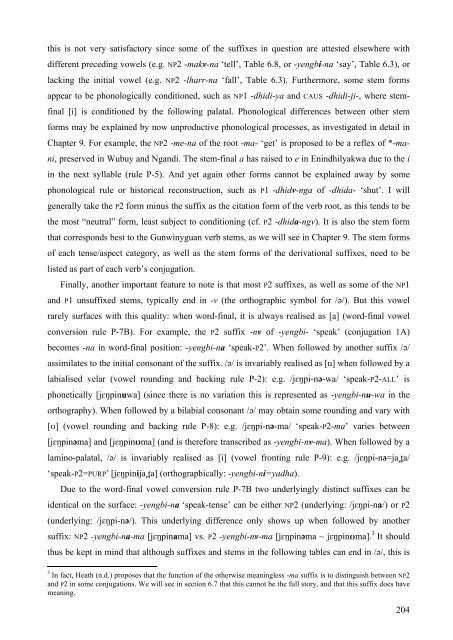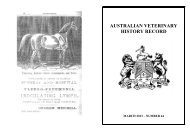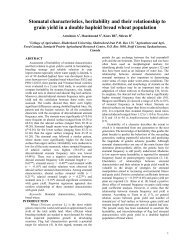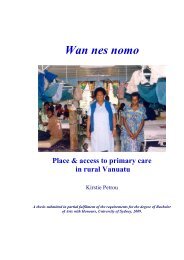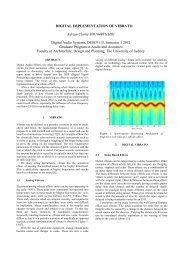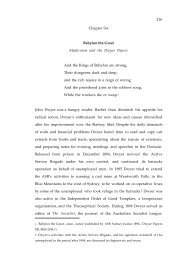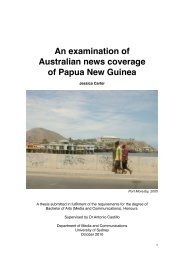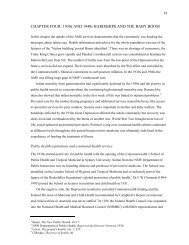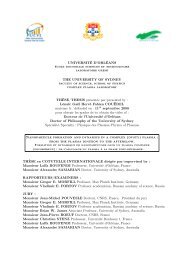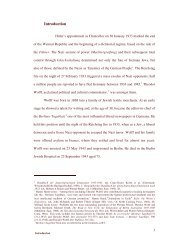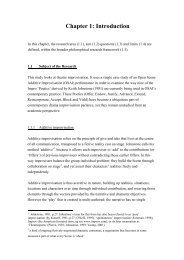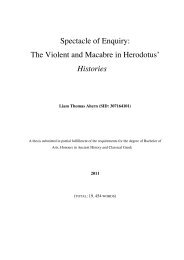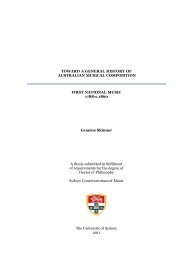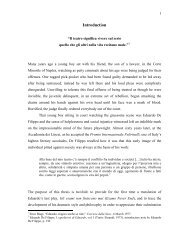Chapter 6: Tense, aspect and mood
Chapter 6: Tense, aspect and mood
Chapter 6: Tense, aspect and mood
You also want an ePaper? Increase the reach of your titles
YUMPU automatically turns print PDFs into web optimized ePapers that Google loves.
this is not very satisfactory since some of the suffixes in question are attested elsewhere with<br />
different preceding vowels (e.g. NP2 -makv-na ‘tell’, Table 6.8, or -yengbi-na ‘say’, Table 6.3), or<br />
lacking the initial vowel (e.g. NP2 -lharr-na ‘fall’, Table 6.3). Furthermore, some stem forms<br />
appear to be phonologically conditioned, such as NP1 -dhidi-ya <strong>and</strong> CAUS -dhidi-ji-, where stem-<br />
final [i] is conditioned by the following palatal. Phonological differences between other stem<br />
forms may be explained by now unproductive phonological processes, as investigated in detail in<br />
<strong>Chapter</strong> 9. For example, the NP2 -me-na of the root -ma- ‘get’ is proposed to be a reflex of *-ma-<br />
ni, preserved in Wubuy <strong>and</strong> Ng<strong>and</strong>i. The stem-final a has raised to e in Enindhilyakwa due to the i<br />
in the next syllable (rule P-5). And yet again other forms cannot be explained away by some<br />
phonological rule or historical reconstruction, such as P1 -dhidv-nga of -dhida- ‘shut’. I will<br />
generally take the P2 form minus the suffix as the citation form of the verb root, as this tends to be<br />
the most “neutral” form, least subject to conditioning (cf. P2 -dhida-ngv). It is also the stem form<br />
that corresponds best to the Gunwinyguan verb stems, as we will see in <strong>Chapter</strong> 9. The stem forms<br />
of each tense/<strong>aspect</strong> category, as well as the stem forms of the derivational suffixes, need to be<br />
listed as part of each verb’s conjugation.<br />
Finally, another important feature to note is that most P2 suffixes, as well as some of the NP1<br />
<strong>and</strong> P1 unsuffixed stems, typically end in -v (the orthographic symbol for /əә/). But this vowel<br />
rarely surfaces with this quality: when word-final, it is always realised as [a] (word-final vowel<br />
conversion rule P-7B). For example, the P2 suffix -nv of -yengbi- ‘speak’ (conjugation 1A)<br />
becomes -na in word-final position: -yengbi-na ‘speak-P2’. When followed by another suffix /əә/<br />
assimilates to the initial consonant of the suffix. /əә/ is invariably realised as [u] when followed by a<br />
labialised velar (vowel rounding <strong>and</strong> backing rule P-2): e.g. /jɛŋpi-nəә-wa/ ‘speak-P2-ALL’ is<br />
phonetically [jɛŋpinuwa] (since there is no variation this is represented as -yengbi-nu-wa in the<br />
orthography). When followed by a bilabial consonant /əә/ may obtain some rounding <strong>and</strong> vary with<br />
[ʊ] (vowel rounding <strong>and</strong> backing rule P-8): e.g. /jɛŋpi-nəә-ma/ ‘speak-P2-ma’ varies between<br />
[jɛŋpinəәma] <strong>and</strong> [jɛŋpinʊma] (<strong>and</strong> is therefore transcribed as -yengbi-nv-ma). When followed by a<br />
lamino-palatal, /əә/ is invariably realised as [i] (vowel fronting rule P-9): e.g. /jɛŋpi-nəә=ja ̪ta/<br />
‘speak-P2=PURP’ [jɛŋpinija ̪ta] (orthographically: -yengbi-ni=yadha).<br />
Due to the word-final vowel conversion rule P-7B two underlyingly distinct suffixes can be<br />
identical on the surface: -yengbi-na ‘speak-tense’ can be either NP2 (underlying: /jɛŋpi-na/) or P2<br />
(underlying: /jɛŋpi-nəә/). This underlying difference only shows up when followed by another<br />
suffix: NP2 -yengbi-na-ma [jɛŋpinama] vs. P2 -yengbi-nv-ma [jɛŋpinəәma ~ jɛŋpinʊma]. 3 It should<br />
thus be kept in mind that although suffixes <strong>and</strong> stems in the following tables can end in /əә/, this is<br />
3 In fact, Heath (n.d.) proposes that the function of the otherwise meaningless -ma suffix is to distinguish between NP2<br />
<strong>and</strong> P2 in some conjugations. We will see in section 6.7 that this cannot be the full story, <strong>and</strong> that this suffix does have<br />
meaning.<br />
204


